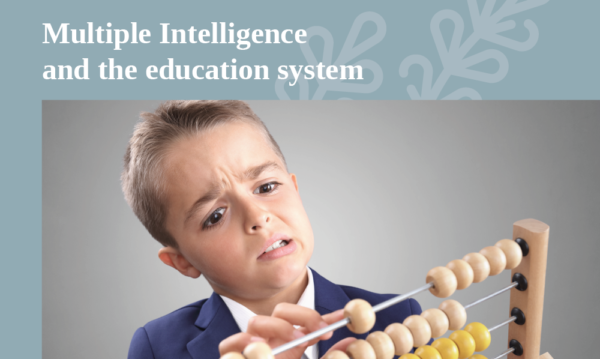Intelligence is the ability to perceive a problem and then solve it or take some practical action for a group of people. Gardner assumed that the individual possesses a unified mix of at least nine types of Intelligence. These types of Intelligence are distinct within the brain, but we inevitably use a mixture of formulas when we act. Therefore, every Intelligence does not work autonomously, but we communicate, we learn, we deal with everyday issues that arise in at least nine ways.
Learning and Multiple Intelligence
Types of Intelligence can be identified, strengthened, taught, and applied. This process is not isolated; each type of Intelligence, that is, can use a variety of ways and means to be taught and understood. For example, Verbal/Language Intelligence can be cultivated through mathematics (e.g., drawings, maps, stories with time references, etc.), or Bodily/Kinesthetic Intelligence can be developed through music (e.g., singing and clapping, rhythmic movements, and dancing, etc.)
Verbal/ Linguistic Intelligence
Verbal – Linguistic Intelligence relates to man’s ability to think with words and use language to express and understand complex concepts. This kind of Intelligence allows us to understand the order and meaning of words and apply post-linguistic skills to reflect on the use of our language. Verbal – Linguistic Intelligence is the most widely common human ability and is highly developed in poets, novelists, journalists, and competent public speakers. Children with “appeal” to this kind of Intelligence enjoy reading, writing, telling stories, or solving crossword puzzles.
Logical-Mathematical Intelligence
Logical-Mathematical Intelligence is the individual’s ability to calculate, quantify, examine sentences and assumptions, and perform complete mathematical operations. It enables the individual to understand relationships and connections, use abstract symbolic thinking, successive reasoning skills, and inductive and abducting thinking. Logical Intelligence is usually highly developed in mathematicians, scientists, and detectives. Children with Logical-Mathematical Intelligence may be excited about dealing with arithmetic problems, strategy games, and experiments.
Bodily-Kinesthetic Intelligence
Physical – Kinesthetic Intelligence is about a person’s ability to handle objects and use various physical skills. This Intelligence also includes a sense of synchronization and perfecting skills through the mind-body association. Athletes, dancers, surgeons, and artisans have well-developed Bodily-Kinesthetic Intelligence.
Musical Intelligence
Musical Intelligence is a person’s ability to distinguish musical rhythm, step, timbre, and tone. This kind of Intelligence allows him to recognize, create, reproduce, and reflect music, as demonstrated by composers, conductors, musicians, singers, and “sensitive” listeners. Interestingly, there is an interactive relationship between music and emotions, and that mathematical and musical Intelligence may share specific standard mental processes.
Interpersonal Intelligence
The person with developed Interpersonal Intelligence can understand and interact effectively with others. Interpersonal Intelligence includes effective verbal and non-verbal communication, the ability to observe differences between others, sensitivity to others’ moods and temperament, and the ability to examine the various topics from different perspectives. Teachers, social workers, actors, politicians exhibit high Interpersonal Intelligence. Children with this kind of Intelligence stand out for their early leadership skills in peer groups and are good at communicating, and seem to understand others’ feelings and motivations.
Intrapersonal Intelligence
Intrapersonal Intelligence is a person’s ability to perceive others, their thoughts, and feelings and use that knowledge to plan and direct their lives. Intrapersonal Intelligence includes an understanding not only of the self but also of the human condition. It is evident to psychologists, spiritual leaders, and philosophers. Children with developed Intrapersonal Intelligence can be shy; they are fully aware of their emotions and operate independently.
Spatial Intelligence
Spatial Intelligence is about a person’s ability to think in three dimensions. Essential skills include mental imaging, spatial reasoning, image and graphics processing, artistic skills, and creative imagination. Sailors, pilots, sculptors, painters, architects present Spatial Intelligence. Children with this kind of Intelligence can get excited about mazes and puzzles or spend their free time planning or daydreaming.
Existential Intelligence
Existential Intelligence relates to the individual’s sensitivity and ability to reflect on more profound questions, such as the meaning of life, why we die, how we got here, what is right and wrong, etc.
Naturalistic Intelligence
A man with a Naturalistic Intelligence is particularly sensitive to all the natural environment’s elements and characteristics. He can quickly identify and classify different kinds of living beings. This ability originates from our evolutionary past, where people were employed as farmers, hunters, food collectors; they continue to play a central role in professions such as botanist or chef.
In these nine kinds of Intelligence, Goleman (1995) came to add the 10th kind of Intelligence, “Emotional Intelligence.” Emotional Intelligence includes self-awareness, self-control, motivation, empathy, and social skills.
The theory of Multiple Intelligence challenges one-dimensional Intelligence (I.Q.), which we cannot change because it remains stable and is measured by various indicators. The new approach is based on multiple scientific research (psychological, anthropological, biological) and is not based on test measurements. Most intelligence tests study either language or logic or both, but do not consider the other eight types of Intelligence.
According to The Multiple Intelligence Theory, all humans possess these kinds of Intelligence. Because of genetic advances and the environment, no two people have the same intelligence profile.
These positions move us from science to education. If all children have different “mind types,” we have several choices and even more chances to change the existing educational system. In schools, we have two options: Ignore these differences, teach all children using the same method, evaluate them in the same way, or recognize each child’s different abilities and reshape the way we teach and assess.
At this point, then, it would be good to ask ourselves and look for the real reasons for children’s refusal to go to school, to read, and their general reactionary behavior concerning school and its activities. One possible interpretation of this behavior may be the fact that the majority of the methods used by most educational systems emphasize the development of only two kinds of Intelligence: Verbal-Linguistic Intelligence and Logical-Mathematical Intelligence. This kind of teaching aims exclusively at sterile memorization of events, dates, and persons – thus ignoring all the skills and talents they can develop through educational activities that promote the development of other types of Intelligence.
In conclusion, another important fact observed in recent years is that more and more children are experiencing learning difficulties, making it difficult, or even unable to meet the education system’s demands structured. Is this increase also due to the education system that cannot meet each student’s specific needs? In other words, why should children have the problem and not the system itself, which is unable to adapt to developments and new demands of children?
References:
Gardner, H., (2000). Intelligence Reframed: Multiple Intelligences for the 21st Century. New York: Basic. Interview with Howard Gardner.


